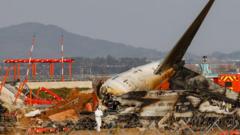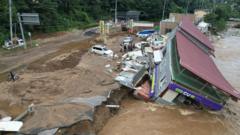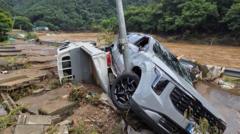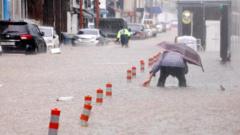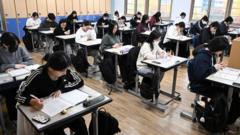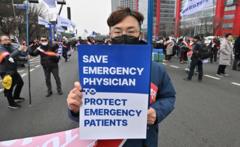Rescue efforts continue in South Korea following devastating landslides and floods caused by days of heavy rainfall, with reports of 18 fatalities and numerous missing as communities work to recover.
Landslides and Floods Devastate South Korea, Claiming 18 Lives

Landslides and Floods Devastate South Korea, Claiming 18 Lives
Torrential rains result in significant loss of life and extensive property damage as communities begin to rebuild.
The catastrophic impact of torrential rain in South Korea has left at least 18 individuals dead, with devastating landslides and floods burying homes under debris. On Monday, the government's disaster management office reported that rescue teams were tirelessly searching for nine people still unaccounted for as the death toll was expected to rise among the wreckage.
Since last Wednesday, a staggering up to 31 inches of rain has inundated the southern and western regions, creating chaos, particularly in Sancheong county. This area has been hardest hit, with 10 reported fatalities and four individuals still missing; nearly 12 inches of rain fell in just a day. The authorities have warned all 33,000 residents of the region to remain vigilant against further landslides and flooding.
Images and videos from the affected areas depict widespread destruction, including battered strawberry greenhouses and overturned vehicles amid the chaos. Aging residents watched despairingly as massive boulders displaced by the rain invaded their yards, while local media reported shortages of power and water services.
In Gapyeong County, a family of four camping by a stream was swept away during the calamity. Although the son was rescued safely, the father was found deceased downstream, and search efforts for the missing mother and young daughter are ongoing.
The national home ministry stated that approximately 14,000 individuals needed evacuation due to the destruction of homes and farms. In terms of agriculture, fields ripe with rice, watermelons, and other crops—spanning an area equivalent to 40,000 soccer fields—have suffered extensive damage. Livestock losses are estimated at nearly 1.5 million, including around 1.4 million chickens.
President Lee Jae Myung has pledged special disaster zone status for the severely affected villages, facilitating tax exemptions and relief measures from the government. As the rains have subsided and sunshine returns to the region, many evacuated locals have begun to return to assess the damage and start rebuilding efforts. To aid recovery, soldiers have been deployed to assist in moving damaged belongings, while construction teams are clearing debris and repairing access routes.
Yet, as weather officials have downgraded the heavy rain alerts, they continue to forecast additional rain for some regions and warn of a looming heatwave in the south, prompting health officials to spray chemicals to mitigate the risk of disease outbreaks in the aftermath.
Since last Wednesday, a staggering up to 31 inches of rain has inundated the southern and western regions, creating chaos, particularly in Sancheong county. This area has been hardest hit, with 10 reported fatalities and four individuals still missing; nearly 12 inches of rain fell in just a day. The authorities have warned all 33,000 residents of the region to remain vigilant against further landslides and flooding.
Images and videos from the affected areas depict widespread destruction, including battered strawberry greenhouses and overturned vehicles amid the chaos. Aging residents watched despairingly as massive boulders displaced by the rain invaded their yards, while local media reported shortages of power and water services.
In Gapyeong County, a family of four camping by a stream was swept away during the calamity. Although the son was rescued safely, the father was found deceased downstream, and search efforts for the missing mother and young daughter are ongoing.
The national home ministry stated that approximately 14,000 individuals needed evacuation due to the destruction of homes and farms. In terms of agriculture, fields ripe with rice, watermelons, and other crops—spanning an area equivalent to 40,000 soccer fields—have suffered extensive damage. Livestock losses are estimated at nearly 1.5 million, including around 1.4 million chickens.
President Lee Jae Myung has pledged special disaster zone status for the severely affected villages, facilitating tax exemptions and relief measures from the government. As the rains have subsided and sunshine returns to the region, many evacuated locals have begun to return to assess the damage and start rebuilding efforts. To aid recovery, soldiers have been deployed to assist in moving damaged belongings, while construction teams are clearing debris and repairing access routes.
Yet, as weather officials have downgraded the heavy rain alerts, they continue to forecast additional rain for some regions and warn of a looming heatwave in the south, prompting health officials to spray chemicals to mitigate the risk of disease outbreaks in the aftermath.

